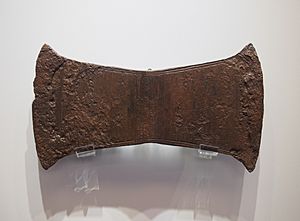Arkalochori Axe facts for kids
The Arkalochori Axe is a special bronze double axe. It is very old, probably from around 1700 BC. This axe was found inside a cave on the island of Crete in 1934. Many other old items were found with it.
Scientists think an earthquake might have closed off the cave a long, long time ago. The axe was likely used in a religious ritual or ceremony. What makes this axe really special is that it has fifteen mysterious symbols carved into it. Some people thought these symbols might be a type of ancient writing called Linear A. However, experts like Professor Glanville Price and Louis Godart believe these symbols are not real writing. They think someone who couldn't read or write carved them, just copying what real Linear A symbols looked like.
Today, the Arkalochori Axe and another famous ancient object called the Phaistos disc are kept safe in the Iraklion Archaeological Museum.
Description
The cave where the Arkalochori Axe was found was used by people for a very long time, starting around 2500 BC. In 1912, before the famous axe was discovered, archaeologists found many other things there. They found 53 bronze swords and 19 double axes. One of these axes was even made of silver!
Double axes like these were very common in the ancient Minoan and Mycenean cultures. You can see them on many ancient objects. For example, a famous stone coffin called the Hagia Triada sarcophagus, which is from about 1400 BC, shows these axes.
When the cave was explored again in 1934, the bigger bronze double axe, about 30 centimeters (12 inches) wide, was discovered. This axe is unique because it has the mysterious carvings on it. The symbols are arranged in three columns. People have compared these symbols to both Linear A writing and the marks on the Phaistos disc. As of 2012, no one has been able to read what the symbols on the axe mean.
Along with this special axe, hundreds of long swords, knives, and other double axes were found in the cave. Most of these items were probably left as offerings to a deity (a god or goddess). However, some of them could still be used. Among the findings were 25 small double axes made of gold and seven made of silver. There was even a tiny golden axe and a tiny silver one, each only about 5 centimeters (2 inches) wide. These two small axes have the same inscription in Linear A:
These four symbols have been read as I-DA-MA-TE. This sounds a lot like the name of the ancient Greek goddess Demeter. The four Linear A symbols also look similar to some of the symbols on the bigger bronze axe. All these discoveries suggest that the cave might have been a temple. It was likely a place where people worshipped a god or goddess connected to military activities.
The Inscription
The Arkalochori Axe has fifteen different symbols carved into it. Two of these symbols seem to be completely unique and haven't been seen anywhere else. Researchers like Torsten Timm (in 2004) have tried to compare these symbols to those found in Linear A writing and on the Phaistos Disc.
Even though some symbols look similar to known ancient writings, many experts believe the inscription on the Arkalochori Axe is not real writing. They think it might be a "pseudo-inscription." This means someone carved symbols that looked like writing but didn't actually form words or sentences. It's still a mystery what the carver intended!
See also
 In Spanish: Hacha de Arkalojori para niños
In Spanish: Hacha de Arkalojori para niños
Images for kids
























